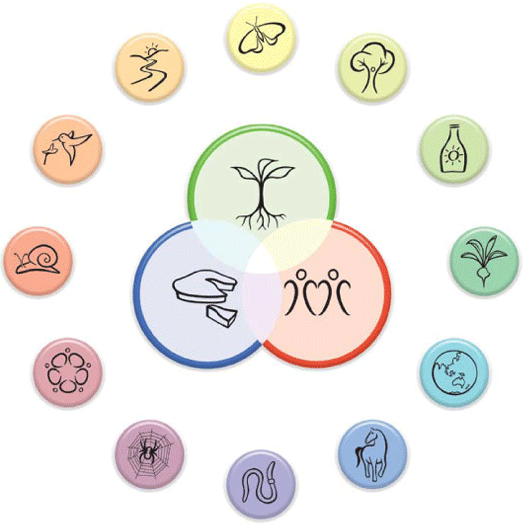
A Revolution Disguised as Gardening
Permanent + (Agri)Culture = Permaculture
Permaculture is a term you've probably heard of; especially if you live in Australia. David Holmgren and Bill Mollison conceived the idea in the early 1970s at the time when environmentalism was becoming less of an idea and more of a practice. David and Bill were working and studying at the University of Tasmania when these pioneering ecologists forged an integrated design system for land management.
But the permaculture framework was always meant to be more than just land based design. Alongside 12 design principles, there are 3 over-arching ethics: care for earth, care for people, and fair share. These ethics inform every part of permaculture. For those in the sustainability sector, those ethics are very familiar. When I first stumbled across permaculture I immediately recognised the similarity between the permaculture ethics and the principles of the Global Green Charter.
After a couple of years of hanging out with permaculturalists - designing gardens, running playgroups, group cooking and chatting about politics - I realised just how deep and interconnected the permaculture principles are, and how easily they can apply to any system; not just your garden.

Permaculture Principles
The Principles, as described by David Holmgren are as follows:
- Observe and Interact – “Beauty is in the mind of the beholder”
By taking the time to engage with nature we can design solutions that suit our particular situation. - Catch and Store Energy – “Make hay while the sun shines”
By developing systems that collect resources when they are abundant, we can use them in times of need. - Obtain a yield – “You can’t work on an empty stomach”
Ensure that you are getting truly useful rewards as part of the working you are doing. - Apply Self Regulation and Accept Feedback – “The sins of the fathers are visited on the children of the seventh generation”
We need to discourage inappropriate activity to ensure that systems can continue to function well. Negative feedback is often slow to emerge. - Use and Value Renewable Resources and Services – “Let nature take its course”
Make the best use of nature’s abundance to reduce our consumptive behavior and dependence on non-renewable resources. - Produce No Waste – “Waste not, want not” or “A stitch in time saves nine”
By valuing and making use of all the resources that are available to us, nothing goes to waste. - Design From Patterns to Details – “Can’t see the forest for the trees”
By stepping back, we can observe patterns in nature and society. These can form the backbone of our designs, with the details filled in as we go. - Integrate Rather Than Segregate – “Many hands make light work”
By putting the right things in the right place, relationships develop between those things and they work together to support each other. - Use Small and Slow Solutions – “Slow and steady wins the race” or “The bigger they are, the harder they fall”
Small and slow systems are easier to maintain than big ones, making better use of local resources and produce more sustainable outcomes. - Use and Value Diversity – “Don’t put all your eggs in one basket”
Diversity reduces vulnerability to a variety of threats and takes advantage of the unique nature of the environment in which it resides. - Use Edges and Value the Marginal – “Don’t think you are on the right track just because it’s a well-beaten path”
The interface between things is where the most interesting events take place. These are often the most valuable, diverse and productive elements in the system. - Creatively Use and Respond to Change – “Vision is not seeing things as they are but as they will be”
We can have a positive impact on inevitable change by carefully observing and then intervening at the right time.
I've chosen to include David's proverbs and descriptions in this list because the 'why' is just as important as the 'what'. Have a good slow read of this list, and then read it again! The important thing to understand about these principles is that they each have their own important role, yet rely on each other to be really successful.
Do Good; Better.
My background is in parliamentary politics, environmental activism and philanthropy; and my work has always been focussed on the big picture stuff. Strategic planning, campaign planning, constitutional reform, if it was macro, I was in. So when I really started to understand how the permaculture principles intersected with each other, I realised the radical potential in regards to social systems.
Imagine you are designing a campaign. It could be a political campaign, an ad campaign or an awareness raising campaign. Most people start with the end product and work backwards.
Problem: I need customers
Solution: I'll advertise!
Design: *grabs pretty picture, pops discount text on top, uploads to internet*
Expected Result: *crosses fingers*
Sometimes this strategy works, and for a lot of online businesses this strategy will lead to a result. However, it probably won't be the best result.
Permaculture design is about understanding energy and the flows of energy and resources. In the context of a campaign, the energies are usually money, people and time. Your challenge is to join those energies together in a way that will give you a yield eg a sale or subscription. The techniques involved in doing so are far too numerous to list here and I will go into strategies in further articles. However, the key principle to start with is the first one: observe and interact. The best place to start practicing this principle is with your own organisation.

See the forest AND the trees
Observation is the arguably the most active principle for the designer of a system as it is constantly occurring. One technique I advocate for my small business clients - and practice myself - is to keep an Observation document on the go. Mine starts with the time tested SWAT headings and I also have a special section on relationships. Following that, I have a monthly reflection section. It doesn't need to be a good looking document (although this is always a good opportunity for a quality notebook!) - the key point is to have as detailed a picture as possible.
Every month I take 5-10 minutes to write down what I've been doing, what I want to be doing, what I've noticed about myself and my business and how we interact. I imagine my business is a landscape and I step back and have a snap shot look at it and write it all down. It's a fascinating process. Many of my assumptions from the beginning of this business have actually proved to be wrong. But I would never have noticed that if I hadn't taken the time to stop and just look.
Super Hero Time
Self reflection is your next super power. Once you get into the habit of practicing observation, you can put your new skill into place in other aspects of your business. Because the second half of the principle - interact - is where you come in. Trying stuff out and seeing what happens. Actively seeing is the key.
Start today and you are on track towards some seriously strategic planning. I would say you'll never look back, but in this case you will! Back, and forward, and back again.
Want to know more about permaculture design and your business? Get in touch and book in your free chat today.